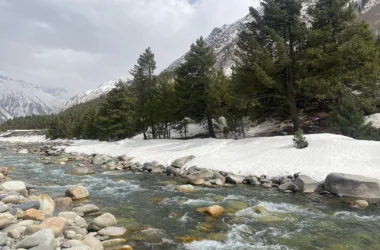Bihar is a holy place for Jains as the last Tirthankara of Jains was born here. A visit to some of the Jain pilgrimage sites in Bihar offers a view of the life and journey of Lord Mahavira. It is in this land that he renounced his worldliness, meditated for years, and preached the Jain way of life for his own liberation. A visit in this circuit provides a visit to many more holy places dedicated to other Jain monks as well.
Places to Visit
Pawapuri Jal Mandir

Jain Pilgrimage
The Jal Mandir (literally Jal Mandir) marks the spot where Lord Mahavira was cremated. It is said that there was such a great demand for ashes from his pyre that the Jal Mandir, as the name suggests, is a temple in the middle of a lotus blossomed lake. The main deity of the beautiful temple is a very old “Charan Paduka” of Lord Mahavira. It marks the place where the mortal remains of Lord Mahavir were cremated. It is believed that this temple was built by King Nandivardhana, the elder brother of Lord Mahavir.
Kundalpur Digambar Jain temple (Nalanda)

Jain Pilgrimage
The Digambara sect of Jains believes that Lord Mahavira, the 24th and last Tirthankara, was born here. This place is called Kundalpur, just 1.6 km away from the ruins of Nalanda. The Digambara sect of Jains believes that Lord Mahavira, the 24th and last Tirthankara, was born here. There are many Jain temples in this village.
Since the place is located around the ancient city of Rajgir, it is one of the popular destinations for pilgrims as well as travelers. The present temple however was built recently. Pictures of 72 gins are displayed for offerings in a separate building. The temple has good accommodation facilities for the devotees.
Lachhuar Jain Temple (Jamui)

Jain Pilgrimage
This Jain temple is the gateway to the place which is believed to be the birthplace of Lord Mahavir.
Built-in 1874, the Jain Temple and Dharamsala at Lachuar is revered by Jains as it serves as the gateway to the Kshatriya Kund Village, which is believed to be the birthplace of Lord Mahavira. It is a large and old rest house (Dharamsala) of 65 rooms built for Jain pilgrims. There is a temple of Lord Mahavir inside Dharamsala.
The idol of this temple is more than 2,600 years old. The weight of this black stone idol is about 250 kg. It is situated on the way to Kshatriya Kund village, the birthplace of Lord Mahavir. This place is located in Sikandra block which is about 20 km. West from Jamui District Headquarters. The temple also organizes regular treks to the Kund.
Read More About Bihar
- Bihar’s rich natural scenery and wildlife
- Buddhist Circuit Bihar: Places to Visit
- Nalanda University: An Ancient Seat of Learning
- Bodh Gaya India: Where Buddha Became Enlightened
Frequently Asked Questions About Jain Pilgrimage
Q. What is Jain Circuit?
A – A visit to some of the Jain pilgrimage sites in Bihar offers a view of the life and journey of Lord Mahavira. A visit to this circuit also provides a visit to many more holy places dedicated to other Jain monks as well.
Q. Which is the holy place of Jains in Bihar?
A – Pavapuri or Pava is a sacred site for Jains located in Nalanda district in the state of Bihar in eastern India. It is situated at a distance of about 19 km from Rajgir and 101 km from Patna, the capital of Bihar. Pavapuri is the place of Nirvana of Mahavira and a pilgrimage site for Jains.
Q. How many Jains are there in Bihar?
A – Jainism is a minority religion of Bihar, practiced by 0.2% of the total population of the state. According to the 2011 census, the Jain population in Bihar is 18,914. As of the 2001 India census, only 16,085 Jains lived in Bihar.
Q. Where do Jains go to worship?
A – Jain Temple or Derasar is a place of worship for Jains, the followers of Jainism. Jain architecture is essentially confined to temples and monasteries, and Jain buildings generally reflect the prevailing style of the place and time in which they were built.
Q. What are the two major sects of Jainism?
A – Jains are divided into two major sects; The Digambara (meaning wearing the sky) sect and the Shvetambara (meaning wearing white) sect. Each of these sects is also divided into subgroups. The two sects agree on the basics of Jainism but disagree on this: the account of Mahavira’s life.
Q. Whom do Jains worship?
A – Of the 24 Tirthankaras, Jains primarily worship four: Mahavira, Parshvanath, Neminatha, and Rishabhanatha. Among the non-pilgrim saints, devotional worship to Bahubali is common among the Digambaras.
Q. Why don’t Jains wear clothes?
A – The monks of this sect completely reject all worldly possessions to lead an ascetic life. Because they are not allowed any property they live without clothes and go “skyclad”, which means naked.












